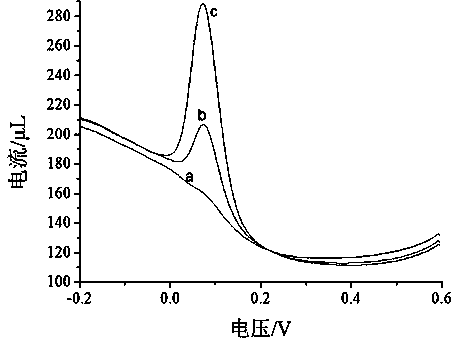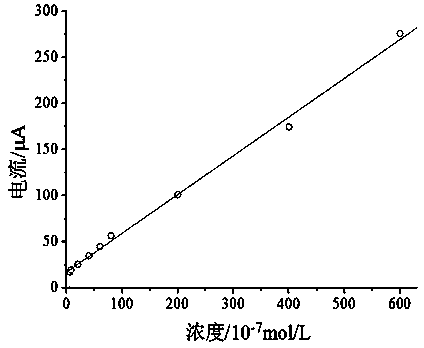Method for detecting trace hydroquinone by using graphene/carbon nano tube modified electrode
A technology of carbon nanotubes and hydroquinone, applied in the field of rapid detection of trace hydroquinone in water, can solve the problems of low resistivity, large specific surface area, etc., achieve simple detection, improve sensitivity and selectivity
- Summary
- Abstract
- Description
- Claims
- Application Information
AI Technical Summary
Problems solved by technology
Method used
Image
Examples
Embodiment Construction
[0023] 1. Treatment of glassy carbon electrodes:
[0024] The surface of the commercially available glassy carbon electrode was sequentially polished with alumina powder of 1.0 μm, 0.3 μm and 0.05 μm in particle size, and then ultrasonically washed in 50% nitric acid, absolute ethanol and secondary water for 10 minute.
[0025] 2. Oxidation of carbon nanotubes:
[0026] Add 30 mg single-walled carbon nanotubes and 20 mL of HNO at a concentration of 6 mol / L to a round bottom flask 3 , reacted in a water bath at 65°C for 20 hours, then filtered with suction, washed with NaOH and secondary water in sequence until the pH of the solution was 7, and oxidized carbon nanotubes (black solid) were obtained.
[0027] 3. Preparation of graphene / carbon nanotube composite nanomaterials:
[0028] The oxidized carbon nanotubes, graphene and NaBH obtained in step (2) were sequentially 4 Add it into a three-necked flask filled with 50 mL of absolute ethanol, disperse it uniformly by ultraso...
PUM
 Login to View More
Login to View More Abstract
Description
Claims
Application Information
 Login to View More
Login to View More - R&D
- Intellectual Property
- Life Sciences
- Materials
- Tech Scout
- Unparalleled Data Quality
- Higher Quality Content
- 60% Fewer Hallucinations
Browse by: Latest US Patents, China's latest patents, Technical Efficacy Thesaurus, Application Domain, Technology Topic, Popular Technical Reports.
© 2025 PatSnap. All rights reserved.Legal|Privacy policy|Modern Slavery Act Transparency Statement|Sitemap|About US| Contact US: help@patsnap.com


